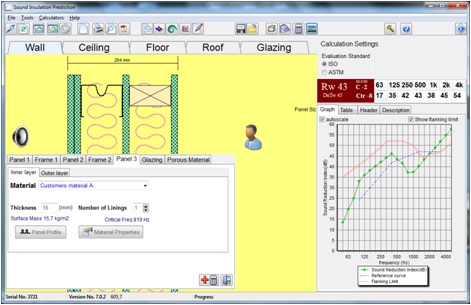INSUL
Software for sound insulation and impact noise predictions
INSUL is software for sound insulation and impact noise predictions written by Marshall Day Acoustics in New Zealand. The software calculates the sound insulation performance of:
- Single walls
- Double and triple walls with many different stud types
- Sound reduction at different angles of incidence
- Sandwich panels
- Profiled steel sheets now working in double skin constructions
- Floors with- or without suspended ceilings. Many different types of connections.
- Fasades
- Double- and triple-glazed windows
- Porous absorbers
The predictions are based on analytical calculations that only need simple data for the design. The software calculates the sound reduction in third-octave bands and the weighted sound reduction indices, Rw, Rw+C50-3150 and RAtr.
INSUL can be used to quickly evaluate new materials and systems, or to investigate the effects of changes to existing designs. It models materials using well known elastic plate theory including allowances for thick panel effects as published by Ljunggren, Rindel and others. More complex partitions are modelled using work by Sharp, Cremer and others. The software can handle the effect of different absorption material in the cavity. Different stud types can be predicted, i. e. wooden studs, steel studs, separated and staggered studs, resilient rail, point connections, rubber isolation clips.
Ceilings with different types of connections, for instance suspended point connections can be handled. The sound insulation of double and triple glazed windows is predicted with a theory different from the double wall theory. Different glass types can be handled.
The Impact noise, Ln,w+C50-2500, is predicted for both light weight timber floors and heavy floors with- or without suspended ceiling and flooring.
INSUL has evolved over several versions over more than 15 years into an easy to use tool and has refined the theoretical models by continued comparison with laboratory tests to provide good accuracy for a wide range of constructions.
In a Swedish research project comparisons were made between INSUL predictions and measurement results from 12 different labs. The conclusion is that INSUL can predict Rw with a mean error of ca 0,5 dB.
INSUL takes account of finite size effects which are very important when predicting small samples such as windows and also for normal elements at low frequencies.
INSUL will greatly enhance the ability of acoustic consultants and product manufacturers to quickly and confidently specify constructions in order to achieve the desired sound insulation.
Features:
- Verified calculation algorithms
- Data base of common materials
- Database of flooring coverings
- The databases are open for editing and adding new materials
- The results can be exported to Excel, Word or Bastian.
- Composite transmission loss calculator
- Outdoor to indoor calculation
- Rain excitation
- Effect of leakage can be estimated
- Auralization
Note that INSUL is not a similar software to Bastian, but they complement each other. INSUL calculates analytically the sound insulation of building elements without the effect of flanking transmission. Bastian, on the other hand, is based on a database of building elements, where the sound insulation is based on a measurement or a calculation. Bastian calculates the flanking transmission. If the building element you want to analyse is missing in the database of Bastian, it is possible to do a calculation with INSUL and complete the database. In fact, a lot of the building elements in the database of Bastian are based on a calculation with INSUL.
INSUL is locked with a hardware USB-dongle. The software can be installed on an unlimited number of computers, but the dongle has to be moved. There is also a network version available, where INSUL and the dongle are installed on one of the computers on the network. INSUL can be operated from all computers connected to the network up to a limited number of users.
Bastian is distributed in Scandinavia by Simmons Akustik & Utveckling www.bastian.nu
You can find more info about INSUL on the developers website www.insul.co.nz
You can download a brochure here
Read about the new 9.0 version here
